
Iconic Foods of Canada: British Columbia
British Columbia is arguably the most beautiful and diverse province in Canada, from the rainforests of Haida Gwaii to the Rocky Mountain towns of Fernie and Golden. There’s the Gulf Islands, where the orcas swim, and Osoyoos, where the cacti grow. The Alaska Highway begins at Dawson Creek, while the Kootenay Pass will get you to Nelson. From the Okanagan orchards to the Tofino surf, this is “Supernatural British Columbia” and these are the foods of British Columbia!
Victoria is the capital – a British colonial city with the second oldest Chinatown in North America, while Vancouver is the largest city. It’s got beaches, mountains, seaplanes, sushi and condos galore! A bike ride around the Stanley Park seawall will make you happy. If not, drive an hour and a half to Whistler for world class skiing and mountain sports.
British Columbia is all about healthy lifestyles and global fusions, fresh ingredients and chef-driven innovation. The cuisine varies from region to region: coastal to mountain, aboriginal to multicultural, hippie commune to yuppie condo. It is not so much based on traditional comfort foods, but the meeting of land and sea, culture and creativity. “West Coast Best Coast”, they say. Let’s take a look!
1. BC Roll
By Lenore Newman
 Dr. Lenore Newman is a writer and urban geographer. She holds a Canada Research Chair in Food Security and Environment, and is an Associate Professor of Geography and the Environment at the University of the Fraser Valley. Lenore studies culinary geographies and has published a book on Canadian cuisine: Speaking in Cod Tongues: A Canadian Culinary Journey.She is passionate about food, and is happiest when cooking, eating, drinking, or sharing meals with friends.
Dr. Lenore Newman is a writer and urban geographer. She holds a Canada Research Chair in Food Security and Environment, and is an Associate Professor of Geography and the Environment at the University of the Fraser Valley. Lenore studies culinary geographies and has published a book on Canadian cuisine: Speaking in Cod Tongues: A Canadian Culinary Journey.She is passionate about food, and is happiest when cooking, eating, drinking, or sharing meals with friends.
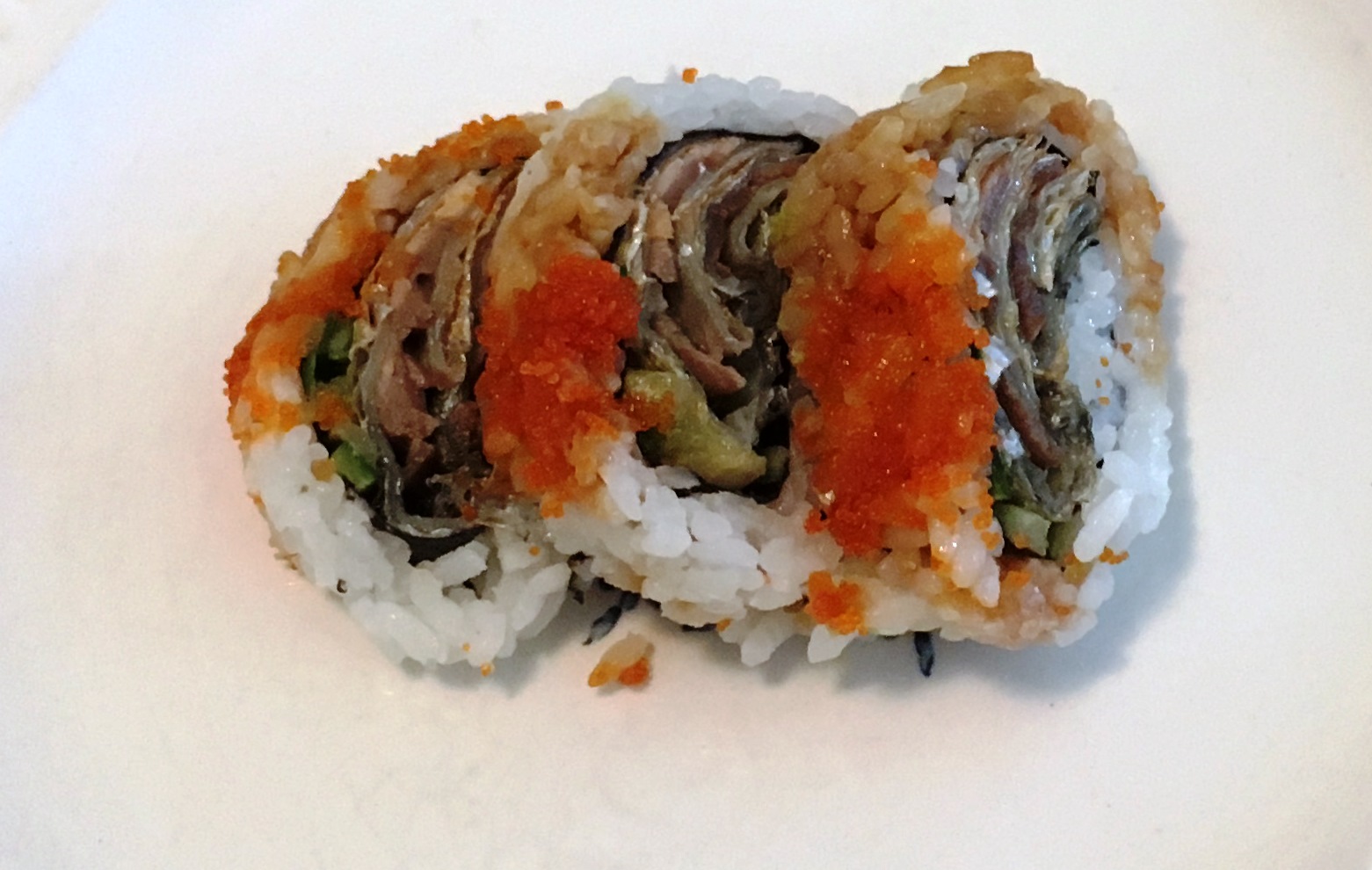
“The BC Roll is a classic and common form of Vancouver style sushi. This simple roll most usually contains cucumber and barbequed salmon that is glazed in a sweet sauce and cooked on a grill with the skin left on. When done properly, the skin is crispy and the flesh of the fish still moist. The roll is usually completed in a Western style with the rice on the outside of the nori.
I once spoke with Chef Hidekazu Tojo about the roll, which he created in 1974. Originally he was simply looking for a substitute for anago, or eel, as they were hard to source in Vancouver, but his substitution was so popular it led him to experiment with other local and seasonal foods.
Japan’s Ministry of Agriculture does not consider such creole dishes as proper examples of classical Washoku cuisine, but as with Hawaii’s spam sushi, BC Rolls demonstrate the culinary mixing common to the Pacific region, and are an excellent example of British Columbia’s cuisine.”
2. Okanogan Fruit
By: Colleen from The Food Blog
 Colleen has a passion for cooking and photography, and loves living in the Okanagan valley with its wealth of fresh seasonal produce. The Food Blog is where she shares her passion for fresh, local, seasonal food from scratch.
Colleen has a passion for cooking and photography, and loves living in the Okanagan valley with its wealth of fresh seasonal produce. The Food Blog is where she shares her passion for fresh, local, seasonal food from scratch.
“When I think of Okanagan food, of course, I think about the fruit. The fruit that grows here in this valley has always been what the Okanagan is about. British Columbia grows more fruit than any other province in Canada, according to Statistics Canada. And the Okanagan Valley is where most of that fruit is grown.
I’ve lived here in the Okanagan for 25 years, but even before that, I remember making family treks to the Okanagan to buy cherries, peaches and apples.
Having a back-yard orchard really solidified my fruit experience here. The first home that I bought on my own had five fruit trees in the back yard. We had a peach, nectarine, apricot, cherry, and a plum tree. This kept me busy canning and jam making every summer.
The orchards have now started to give way here, to vineyards, as the wine industry here has blossomed in the last couple of decades. The Okanagan is now home to 120 wineries (and counting), many of them award winning. And vineyards are a big part of our landscape now. And with the wine, comes the cuisine.
The Okanagan Valley has a thriving food culture, built around the wineries, as great chefs come here to cook and prepare the abundance of fresh, local ingredients to pair with the wines. Some of the best restaurants here are winery restaurants. If you come to the Okanagan, check out Old Vines at Quail’s Gate, The Terrace at Mission Hill, and Grey Monk Estate, among so many others, for locally inspired food cooked by outstanding chefs.
But the fruit. To me, fruit will always be the essence of the Okanagan. And this simple recipe for Spiced Rum Grilled Peaches, using tree ripened Okanagan peaches, showcases that perfectly, I think.”
Did You Know? British Columbia is full of wild and cultivated berries, from survival foods like bearberries (kinnikinnick) to the largest production of high bush blueberries in Canada. Blackberries grow in abundance, as well as their cousins and hybrids: salmonberries, boysenberries, thimbleberries and loganberies. Others are salal, strawberries, huckleberries and Oregon grapes.
3. JapaDog
Canada has the 6th largest Japanese community in the world outside of Japan, and the majority of this population resides in Vancouver, BC. British Columbia has a long history of Japanese immigration, dating back to 1877. This influence is apparent in Vancouver’s sushi culture, and its many izakayas and ramen joints.
But one Japanese couple moved to Vancouver as recently as 2005, and had a lasting effect on the North American hot dog. Noriki Tamura moved to Canada with his wife, planning to sell crepes as a street vendor. His plans were thwarted by Vancouver’s street vending laws so Tamura came up with another idea: Japanese fusion hot dogs! This was the beginning of Japadog, which has enjoyed international acclaim and, of course, many imitators.
Japanese ingredients are placed on a snappy casing hot dog (pork, beef, turkey or veggie). The Terimayo is the best seller, topped with nori seaweed, Japanese mayo and teriyaki sauce. This Vancouver signature is one of my favourite foods of British Colubmia!
4. Dungeness Crab
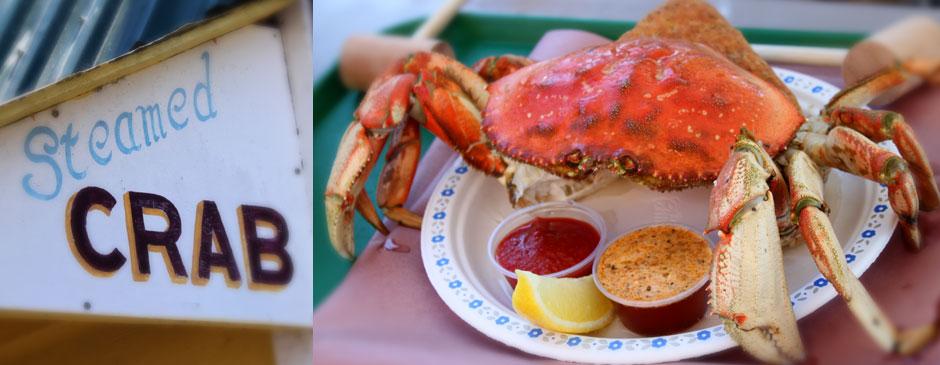 Photo Courtesy of The Fish Store at Fisherman’s Wharf
Photo Courtesy of The Fish Store at Fisherman’s Wharf
Being a coastal province, it is inevitable that many of the most iconic foods of British Columbia are seafoods! Dungeness crabs can be found along the Pacific Coast from the Aleutian Islands to Mexico, and are British Columbia’s favourite crustacean. There is a commercial fishery, sport fishing and aboriginal fishing that predates everything else.
Whereas a lobster license on the east coast is prohibitively expensive (and you can be fined for plucking a lobster out of the water), in BC a Tidal Waters License can be bought online for as little as $5.51 (or free if you’re under 16).
If you don’t feel like wearing hip waders in the low tide muck, you can always buy your crab fresh off the boat at The Fish Store at Fisherman’s Wharf in Victoria or The Lobster Man on Granville Island in Vancouver. Or you could fancy it up and dine at the Sandbar (just down the road), Blue Water Cafe or Sun Sui Wah for a Chinese preparation.
5. Wild Pacific Salmon
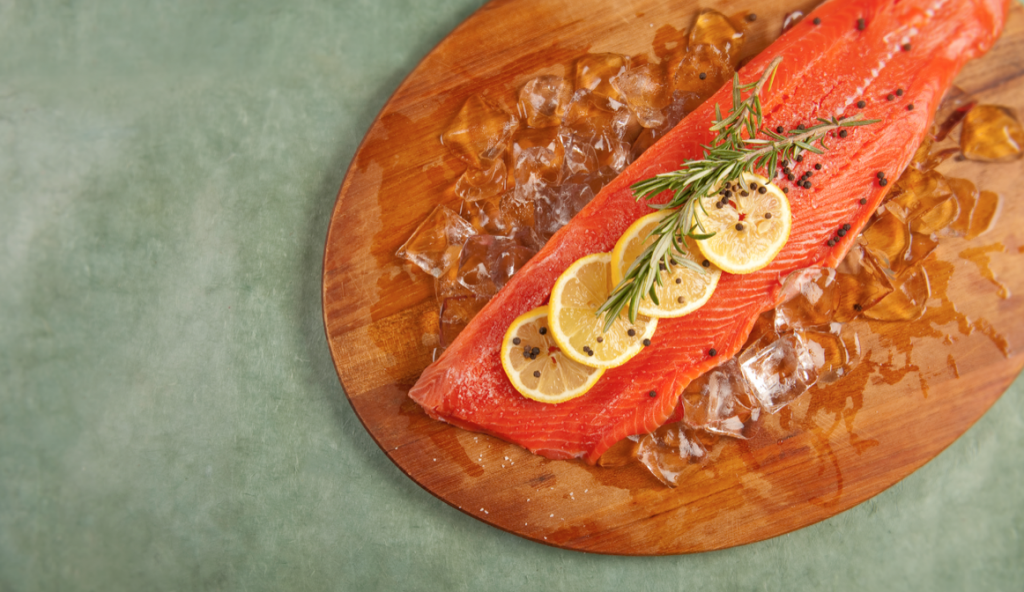 Photo of Sockeye Salmon, from Daily Catch Seafood
Photo of Sockeye Salmon, from Daily Catch Seafood
There are lots of great fish to be had off the coast of BC: halibut, Pacific cod, sablefish, lingcod and tuna are a few. But when one thinks of foods of British Columbia, it is salmon that comes to mind! The coastal First Nations of BC are thought to have one of the world’s oldest fisheries, and salmon continues to be central to aboriginal traditions and diets.
The Chinook (King Salmon) is the largest, fattiest and most prized of them all. Locals will argue whether the rare white fleshed “Spring Salmon” is superior to red-fleshed chinook.
Then there’s the brilliant dark red-orange flesh of the Sockeye, and the equally prized Coho. Less desirable are the Pink and Chum salmons, but there are attempts to re-market these sustainable and abundant fish. Chum is often sold as “Silverbrite” (a more appealing name) and the Vancouver Pink Salmon Festival gives exposure to this undervalued fish.
Hot smoking is a traditional way of preserving salmon, dating back thousands of years to aboriginal fires. Hot smoked salmon continues to be a favorite preparation, along with Salmon Candy which is smoked salmon glazed with maple syrup. There are also many purveyors of Salmon Jerky and Smoked Salmon Paté.
Salmon burgers are abundant in BC pubs and sockeye is a choice fish for sushi. Salmon fish ‘n chips are not uncommon, alongside the usual halibut and cod.
Stevenson is a historic fishing village (now part of Richmond) that used to be called “Salmonopolis” due to its salmon canning industry. The Gulf of Georgia Cannery is a museum and National Historic Site, and the Stevenson Salmon Festival is held every year on Canada Day, with its famous salmon barbecue.
Prince Rupert, in northern BC, is home to the North Pacific Cannery National Historic Site.
Did You Know? British Columbia is home to the most ancient and varied aboriginal cultures in Canada (198 First Nations and 7 language groups). BC is a great place to discover Indigenous Tourism and cuisine (check out Salmon n’ Bannock Bistro). A few unique indigenous foods include miner’s lettuce, camas bulbs, salal berries, “Indian Ice Cream” (whipped soapberries) and herring spawn on kelp, which is exactly as it sounds.
6. Doukhobor Borscht
The Doukhobors are a sect of Russian dissenters, pacifists, and vegetarians who were persecuted due to their beliefs. The migration of Doukhobors to Canada at the turn of the 20th century was the largest single mass migration in Canadian history. They originally settled in Saskatchewan, but most of them relocated to the Kootenay region of BC.
Grand Forks is a centre of Doukhobor culture and famous for its borscht. You can try some at The Borscht Bowl.
Doukhobor borscht is distinguished from its ruby red counterparts by its creamy orange colour imparted by dairy cream and mashed potatoes. Beets are optional. Dill is not. I first discovered Doukhobor cuisine in Nelson, where the Old World Bakery was selling a “White Doukhobor Borscht”. I was intrigued and immensely satisfied by this hearty vegetarian soup.
7. Nanaimo Bars
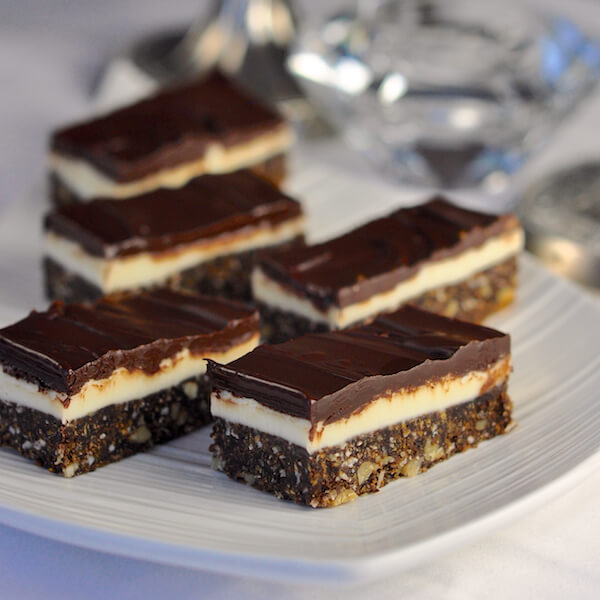 Photo Courtesy of Rock Recipes
Photo Courtesy of Rock Recipes
The Nanaimo Bar might very well be Canada’s favourite confection, whether served as a church “dainty” or a giant cafe slab. Accused of being “too sweet” this triple layered square has a chocolate graham cracker coconut base, a creamy custard middle and a chocolate ganache top.
The origins of the Nanaimo Bar are murky, but Canada Research Chair Lenore Newman (who wrote about the BC Roll at the top of this post) has done extensive academic research on the topic which you can read here. What we do know is that the recipe (as we know it) first appeared in the Women’s Auxiliary to the Nanaimo Hospital Cookbook in 1952 and that the term “Nanaimo Bar” took hold after it was published in a Vancouver Sun column in 1953. It is possible that the bars achieved nationwide popularity thanks to their inclusion in the Expo ’86 Cookbook.
Either way, Nanaimo is happy to take the credit and promotes their self-guided Nanaimo Bar Trail.
Did You know? Victoria was declared the “Brunch Capital of Canada” by the Food Network on You Gotta Eat Here!, thanks to the brunch obsessed residents who line up down the street for this decadent meal at the plethora of brunch spots around the city. If Hollandaise and coffee ain’t your thang, there’s always the famous Afternoon Tea at the Empress Hotel.
8. Spot Prawns
Spot prawns are the largest commercial shrimp in the Pacific Northwest. They are wild (caught with baited traps), sustainable, and prized for their firm and sweet flesh.
The Spot Prawn Festival is held every May at the False Creek Fishermen’s Wharf in Vancouver.
9. Salt Spring Island Lamb
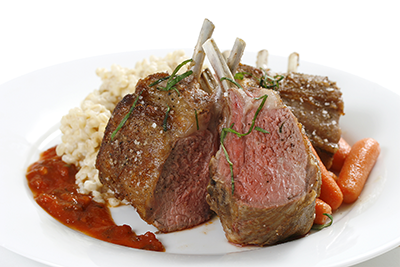 Photo Courtesy of Country Grocer
Photo Courtesy of Country Grocer
Salt Spring Island Lamb is said to have a superior taste due to its unique terrior. The fresh, salty air is often credited, and the balmy climate allows the sheep to graze year round on wild blackberries, salal and Oregon grapes. There are few predators, and the sheep enjoy small farms with doting farmers.
The Salt Spring Island Cheese Company makes sheep and goats milk cheeses that are among the most reputable in British Columbia.
Did You Know? Canadian legend credits the “Lumberjack Breakfast” to a hotel in pre-railway Gastown (Vancouver). This excessive feed of meats, eggs and pancakes was meant to fuel loggers and millworkers for a hard day’s work.
Did You Also Know? The so-called “Chinese Smorgasbord” is also said to have originated in Gastown when Scandinavian loggers asked Chinese cooks to lay the food out on a sideboard instead of serving individual plates. To this day, it is common in Western Canada to go out for “Smorgasbord” (Chinese Buffet). In some places the buffet will have both Chinese and Ukrainian offerings side by side.
10. Butter Chicken Pizza
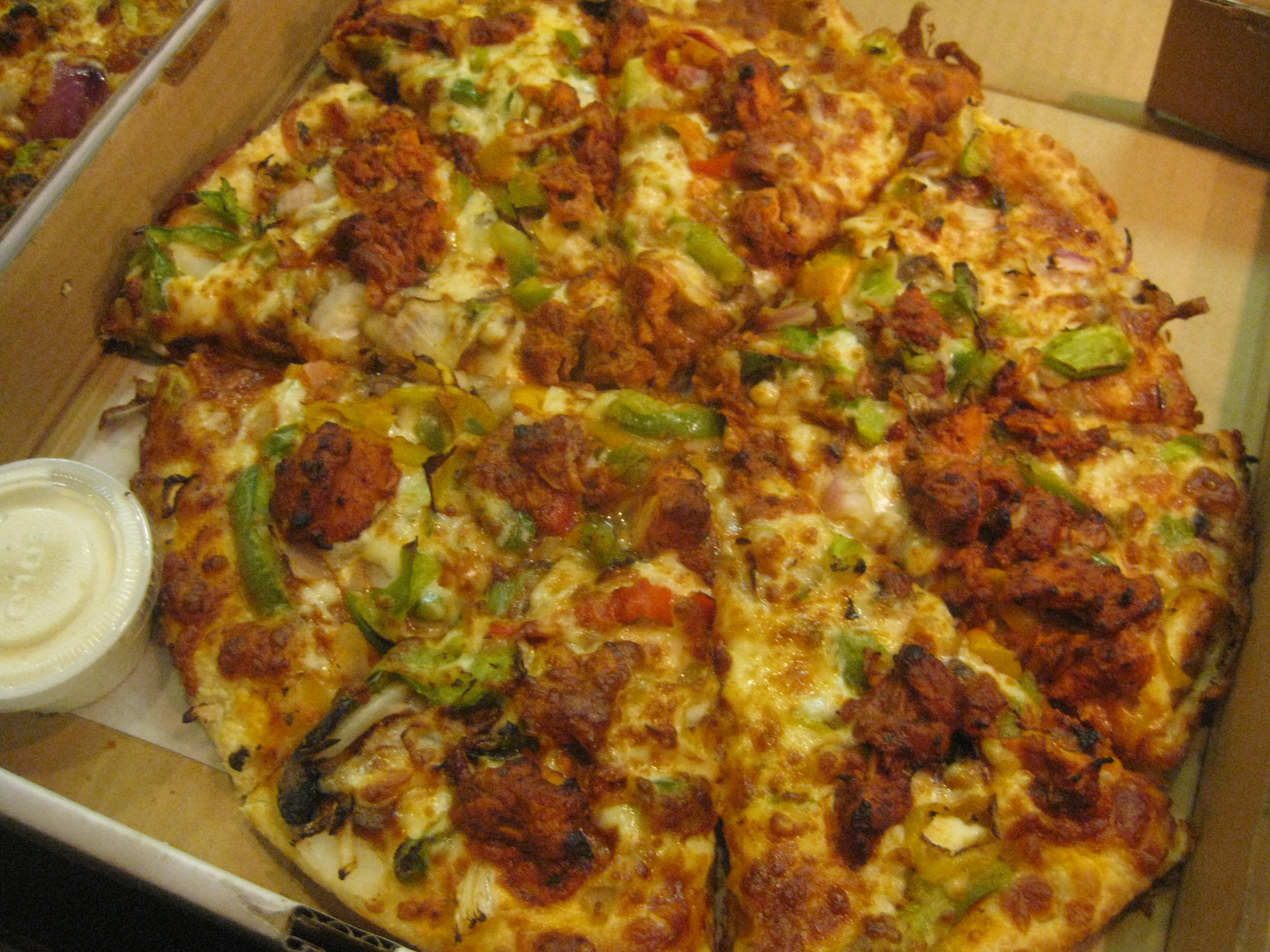 Butter Chicken Pizza from Camy’s
Butter Chicken Pizza from Camy’s
Vancouver is mostly known for its simple buck-a-slice pizza, but an interesting phenomenon (aside from all the great Neapolitan pizzerias) is the Indian pizza.
British Columbia has the highest population of Indo-Canadians by percentage, and Vancouver has the second largest South Asian community of any Canadian city (after Toronto). It is no surprise, then, that Vancouver has great Indian food! Vij’s, for exmaple, is one of the most celebrated restaurants in Canada!
Surrey, Burnaby, Richmond, Abbotsford, Delta and the Fraser Valley have large Indian populations, and many Indian-owned pizzerias offer varieties like butter chicken, tandoori chicken and paneer.
Other foods of British Columbia: Beef and blue cheese pizza, fish tacos (esp. Tacofino and Red Fish Blue Fish), hand pulled noodles, izakaya cuisine, west coast oysters, bay scallops, dim sum.
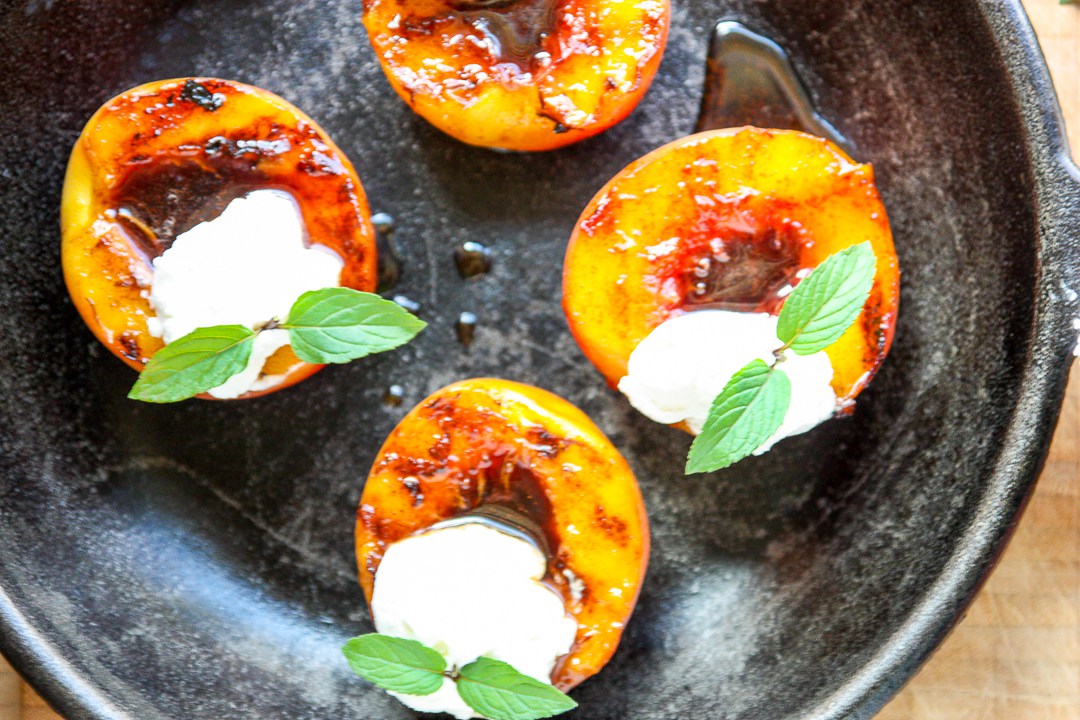


11 Comments
Johnston Farrow
Butter Chicken Pizza? Sign me up!
Destiny
i never had the butter chicken pizza before.
Jirelle
heck yeah
Colleen
Hi Lindsay,
I’ve been enjoying following your cross Canada journey. Every post is so interesting, well researched, and informative! (Not to mention hunger inducing :-))Thanks for including my little blurb about the Okanagan.
Kent
I came for the NS Pizza reviews and was impressed when you nailed the iconic foods of BC. I am a foodie and a transplant to Halifax after 30 years in BC. Before I scrolled on down on this article I told myself “Self, if she doesn’t have spot prawns, Dungies, and something about Asian food she doesn’t have a clue what she is talking about”…
Family friends (The Hardcastle’s) are the holders of the official Nanaimo Bar, never tried making it myself but the City of Nanaimo website has the recipe. Joyce didn’t invent it she just submitted her take on the recipe as a part of a competition in 1986 and won. https://www.nanaimo.ca/about-nanaimo/nanaimo-bars
Thanks for the East Dartmouth Pizza review
Eat This Town
That’s awesome! I’m glad you enjoyed the BC post, and I hope I was able to help you out with your neighbourhood pizza choices!
Igor Zbitnoff
Among Doukhobors there are differences of opinion about how best to transliterate борщ. I prefer “borsch” or “borshch.”
Kathryn Cuming
How does one get the spiced rum grilled peach recipe? I have no idea how to get on the food blog.
Eat This Town
Thanks for alerting me to this problem! I’ve contacted the blogger and she said her site is down, but it will be back up soon.
Drew Kristy
Hi! This list of delicious foods of Canada (BC) is so amazing, especially this butter chicken pizza. Looking so delicious. Thanks for sharing.
James Reinert
This top ten list pretty much nailed it. However, there are a few other iconic BC foods that most people here may not be aware are unique to or came from our region: Cumberland Chow mein and the Buddha bowl. A popular misconception is that the Buddha bowl came from San Fran, but the dish was first posted the Gumboot Cafe’s website, which is a cafe in Robert’s Creek. Also, most people who live in BC, if they’ve had chow mein, they’ve most likely had Cumberland chow mein, which was invented in Cumberland, BC. And, of course, there’s Stilton cheese cake, BC wine, and cold alder smoked salmon (a necessary ingredient for many types of sushi), and Himalayan blackberry jam, as well. Sunshine Coasters will claim that water cress pesto is theirs, as well as eggs-benedict made with duck eggs. And, of course, some will argue that the California roll was invented by chef Tojo in Vancouver. I’m sure there’s more, too many to list here, perhaps. Someone should write a cookbook about BC regional cuisine. I’m certain we’d all be surprised to realize that we actually have our own regionally unique cuisine, however young it may be.